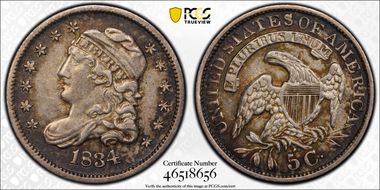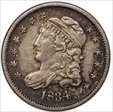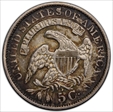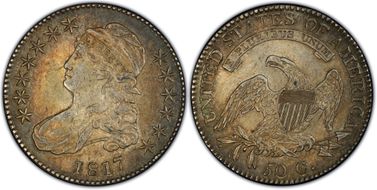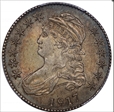ponderit 的钱币相册
This splendid AU58 is a great example of a coin that has not been "treated". Its thick skin screams "original" and its toning color is progressive and authentic, pleasantly growing from rims inward. Surely from decades of album storage. Surfaces are very clean with no disturbances. Strike is solid. Rims and denticles are complete from a well centered strike. Stars are crisp with evident center points. Star 13 is not scalloped...proof that this coin was struck from an obverse die made from Scot's new master, not from Reich's (whose scalloped S13 was his signature). All in all, an original and very appealing 1817 O.110 1817...the year the Mint recovered from a devastating fire that consumed the mill house and the adjoining building with the rolling and drawing machines...the year work on the Erie Canal began...and just two years after the war of 1812 ended...CBH production resumed in earnest. Fun varieties followed. The fabulously apparent 1817 over 3 overdate. The punctuated 181.7 blunder with its broken I punch rendering cryptic reverse legend spelling. The O.106a single leaf resulting from over zealous die maintenance. And who can forget the king of all overdates, the uber rare 1817/4? 1817 is also sadly remembered as the year assistant engraver John Reich left the Mint. Chief Engraver Robert Scot took over, producing a new obverse master die which lowered the relief. 1817 yeardate strikes are generally pretty good. Weakness at the obverse center is common while reverse strikes are mostly trouble free.
This splendid AU58 is a great example of a coin that has not been "treated". Its thick skin screams "original" and its toning color is progressive and authentic, pleasantly growing from rims inward. Surely from decades of album storage. Surfaces are very clean with no disturbances. Strike is solid. Rims and denticles are complete from a well centered strike. Stars are crisp with evident center points. Star 13 is not scalloped...proof that this coin was struck from an obverse die made from Scot's new master, not from Reich's (whose scalloped S13 was his signature). All in all, an original and very appealing 1817 O.110 1817...the year the Mint recovered from a devastating fire that consumed the mill house and the adjoining building with the rolling and drawing machines...the year work on the Erie Canal began...and just two years after the war of 1812 ended...CBH production resumed in earnest. Fun varieties followed. The fabulously apparent 1817 over 3 overdate. The punctuated 181.7 blunder with its broken I punch rendering cryptic reverse legend spelling. The O.106a single leaf resulting from over zealous die maintenance. And who can forget the king of all overdates, the uber rare 1817/4? 1817 is also sadly remembered as the year assistant engraver John Reich left the Mint. Chief Engraver Robert Scot took over, producing a new obverse master die which lowered the relief. 1817 yeardate strikes are generally pretty good. Weakness at the obverse center is common while reverse strikes are mostly trouble free.
This splendid AU58 is a great example of a coin that has not been "treated". Its thick skin screams "original" and its toning color is progressive and authentic, pleasantly growing from rims inward. Surely from decades of album storage. Surfaces are very clean with no disturbances. Strike is solid. Rims and denticles are complete from a well centered strike. Stars are crisp with evident center points. Star 13 is not scalloped...proof that this coin was struck from an obverse die made from Scot's new master, not from Reich's (whose scalloped S13 was his signature). All in all, an original and very appealing 1817 O.110 1817...the year the Mint recovered from a devastating fire that consumed the mill house and the adjoining building with the rolling and drawing machines...the year work on the Erie Canal began...and just two years after the war of 1812 ended...CBH production resumed in earnest. Fun varieties followed. The fabulously apparent 1817 over 3 overdate. The punctuated 181.7 blunder with its broken I punch rendering cryptic reverse legend spelling. The O.106a single leaf resulting from over zealous die maintenance. And who can forget the king of all overdates, the uber rare 1817/4? 1817 is also sadly remembered as the year assistant engraver John Reich left the Mint. Chief Engraver Robert Scot took over, producing a new obverse master die which lowered the relief. 1817 yeardate strikes are generally pretty good. Weakness at the obverse center is common while reverse strikes are mostly trouble free.
This splendid AU58 is a great example of a coin that has not been "treated". Its thick skin screams "original" and its toning color is progressive and authentic, pleasantly growing from rims inward. Surely from decades of album storage. Surfaces are very clean with no disturbances. Strike is solid. Rims and denticles are complete from a well centered strike. Stars are crisp with evident center points. Star 13 is not scalloped...proof that this coin was struck from an obverse die made from Scot's new master, not from Reich's (whose scalloped S13 was his signature). All in all, an original and very appealing 1817 O.110 1817...the year the Mint recovered from a devastating fire that consumed the mill house and the adjoining building with the rolling and drawing machines...the year work on the Erie Canal began...and just two years after the war of 1812 ended...CBH production resumed in earnest. Fun varieties followed. The fabulously apparent 1817 over 3 overdate. The punctuated 181.7 blunder with its broken I punch rendering cryptic reverse legend spelling. The O.106a single leaf resulting from over zealous die maintenance. And who can forget the king of all overdates, the uber rare 1817/4? 1817 is also sadly remembered as the year assistant engraver John Reich left the Mint. Chief Engraver Robert Scot took over, producing a new obverse master die which lowered the relief. 1817 yeardate strikes are generally pretty good. Weakness at the obverse center is common while reverse strikes are mostly trouble free.
This splendid AU58 is a great example of a coin that has not been "treated". Its thick skin screams "original" and its toning color is progressive and authentic, pleasantly growing from rims inward. Surely from decades of album storage. Surfaces are very clean with no disturbances. Strike is solid. Rims and denticles are complete from a well centered strike. Stars are crisp with evident center points. Star 13 is not scalloped...proof that this coin was struck from an obverse die made from Scot's new master, not from Reich's (whose scalloped S13 was his signature). All in all, an original and very appealing 1817 O.110 1817...the year the Mint recovered from a devastating fire that consumed the mill house and the adjoining building with the rolling and drawing machines...the year work on the Erie Canal began...and just two years after the war of 1812 ended...CBH production resumed in earnest. Fun varieties followed. The fabulously apparent 1817 over 3 overdate. The punctuated 181.7 blunder with its broken I punch rendering cryptic reverse legend spelling. The O.106a single leaf resulting from over zealous die maintenance. And who can forget the king of all overdates, the uber rare 1817/4? 1817 is also sadly remembered as the year assistant engraver John Reich left the Mint. Chief Engraver Robert Scot took over, producing a new obverse master die which lowered the relief. 1817 yeardate strikes are generally pretty good. Weakness at the obverse center is common while reverse strikes are mostly trouble free.




















